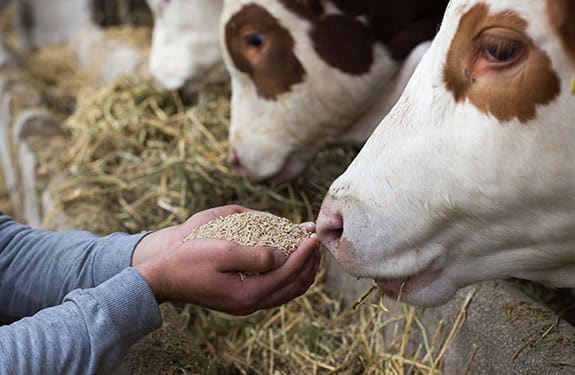12 Feb Actisaf® Sc 47 yeast probiotic boosts feed efficiency and performance
Mohamed Mammeri, PhD, Global Product Manager, Phileo by Lesaffre, & Maxime Briche, EU & CIS Ruminant Manager, Phileo by Lesaffre.
 Feeding the world’s population during this challenging period will require to improve feed efficiency and fiber degradation to benefit global food production.
Feeding the world’s population during this challenging period will require to improve feed efficiency and fiber degradation to benefit global food production.
Phileo by Lesaffre wishes to assist customers during this time by offering a knowledge framework to help address current and future ruminant demands. This includes focusing on the proven capacity of Actisaf® Sc 47, a premium yeast probiotic, to help improve rumen health and feed conversion efficiency, leading to better herd performance and improved overall stock condition. Feed efficiency, as a key component of sustainable ruminant production, is a priority requirement in today’s world, as the following analysis shows:
 Ruminants are able to digest high-fiber feed due to the bacterial fermentation processes which occur in the rumen, which is arguably the most important organ in their digestive system. The rumen is a complex ecosystem composed of anaerobic bacteria, protozoa, fungi and archaea. These microbes interact to break down plant material, whilst providing metabolic energy to animals. Rumen microflora is therefore strongly linked with feed efficiency.
Ruminants are able to digest high-fiber feed due to the bacterial fermentation processes which occur in the rumen, which is arguably the most important organ in their digestive system. The rumen is a complex ecosystem composed of anaerobic bacteria, protozoa, fungi and archaea. These microbes interact to break down plant material, whilst providing metabolic energy to animals. Rumen microflora is therefore strongly linked with feed efficiency.
Published studies show that Actisaf® Sc 47 stabilizes the rumen microbiota by increasing the pH and making the environment more reducing, which is likely to favor some bacterial communities. The microbiota of cows whose diets are supplemented with the yeast probiotic show a high number of shared Operational Taxonomic Units (OTU) between animals, confirming the presence of a strong core microbiota. In fact, Actisaf® Sc 47 modulates the rumen biotope by causing a shift in the main fibrolytic group (Fibrobacter, Eubacter and Ruminococcus) and lactate-utilizing bacteria (Megasphaera and Selenomonas species), the latter being strictly anaerobic (Figure 1). Findings also reveal that the supplement has a ‘dose-effect’ with the best balancing of the microbiota being obtained at a diet inclusion of 5 g/cow/day in optimum conditions (Pinloche et al., 2013). Thus, Actisaf® Sc 47 improves rumen microbiota, boosting feed efficiency and raising herd performance consistency.
 The supplement increases the relative abundance of fibrolyitic and lactic-acid utilizing bacteria by strengthening the reducing conditions of the ruminal environment. This helps reduce the risk of acidosis, increase VFA concentration and digestibility, resulting in greater feed efficiency. Lowering redox potential, due to Actisaf® Sc 47, stimulates fibrolytic bacteria which improves feed digestibility. While it is reported that the yeast probiotic and bicarbonate have similar effects on the cellulolytic population, digestibility data shows that yeast increases neutral detergent fiber (NDF) digestibility but bicarbonate does not (Figure 2). This suggests that the supplement not only increases the proportion of cellulolytic bacteria but also stimulates their activity. In addition, using Actisaf® Sc 47 results in higher total tract digestibility of NDF and ADF (Acid Detergent Fiber) (Marden et al., 2008), suggesting better assimilation in the gastrointestinal tract and an increase in properly valued forages.
The supplement increases the relative abundance of fibrolyitic and lactic-acid utilizing bacteria by strengthening the reducing conditions of the ruminal environment. This helps reduce the risk of acidosis, increase VFA concentration and digestibility, resulting in greater feed efficiency. Lowering redox potential, due to Actisaf® Sc 47, stimulates fibrolytic bacteria which improves feed digestibility. While it is reported that the yeast probiotic and bicarbonate have similar effects on the cellulolytic population, digestibility data shows that yeast increases neutral detergent fiber (NDF) digestibility but bicarbonate does not (Figure 2). This suggests that the supplement not only increases the proportion of cellulolytic bacteria but also stimulates their activity. In addition, using Actisaf® Sc 47 results in higher total tract digestibility of NDF and ADF (Acid Detergent Fiber) (Marden et al., 2008), suggesting better assimilation in the gastrointestinal tract and an increase in properly valued forages.
 By stabilizing and balancing the rumen environment, the supplement improves cow digestion and nutrient availability, leading to improved productivity and releasing the full genetic potential of the herd. Many studies have reported an improvement in milk production in cows which are supplemented with Actisaf® Sc 47 at 5g/c/d. Trials have shown that cows given the supplement increased milk production by an average of 1.86 kg/day. It stabilizes the rumen ecosystem, leading to a more consistent and steady response to diet changes and other stress conditions (such as heat stress). When added to the feed, therefore, the supplement secures ruminant performance and the animal’s response to stress or other challenges. In multiple global trials, Actisaf® Sc 47 has repeatedly proved its performance and benefits. For example, the supplement’s use in intense heat stress conditions (THI 69 to 79) with high-yielding dairy cows (around 40 kg/day), increased yield and milk fat content (Moallem et al., 2008). A recent study also showed that Actisaf ® Sc 47, given at a dosage of 10 g/d/cow (= 10 x 10¹0 CFU/cow/d) during transition, improved both energy status and metabolism, thereby increasing the supply of energy for milk production (Minuti et al., 2018). Significant lower concentrations of blood haptoglobin and BHB levels in the Actisaf® Sc 47 group (Figure 3), reflected the reduction of both the lipomobilization processes and hepatic ketogenesis, suggesting an improved energy balance, reduced systemic inflammation and a lowering of the risk of sub-clinical ketosis.
By stabilizing and balancing the rumen environment, the supplement improves cow digestion and nutrient availability, leading to improved productivity and releasing the full genetic potential of the herd. Many studies have reported an improvement in milk production in cows which are supplemented with Actisaf® Sc 47 at 5g/c/d. Trials have shown that cows given the supplement increased milk production by an average of 1.86 kg/day. It stabilizes the rumen ecosystem, leading to a more consistent and steady response to diet changes and other stress conditions (such as heat stress). When added to the feed, therefore, the supplement secures ruminant performance and the animal’s response to stress or other challenges. In multiple global trials, Actisaf® Sc 47 has repeatedly proved its performance and benefits. For example, the supplement’s use in intense heat stress conditions (THI 69 to 79) with high-yielding dairy cows (around 40 kg/day), increased yield and milk fat content (Moallem et al., 2008). A recent study also showed that Actisaf ® Sc 47, given at a dosage of 10 g/d/cow (= 10 x 10¹0 CFU/cow/d) during transition, improved both energy status and metabolism, thereby increasing the supply of energy for milk production (Minuti et al., 2018). Significant lower concentrations of blood haptoglobin and BHB levels in the Actisaf® Sc 47 group (Figure 3), reflected the reduction of both the lipomobilization processes and hepatic ketogenesis, suggesting an improved energy balance, reduced systemic inflammation and a lowering of the risk of sub-clinical ketosis.
Actisaf® Sc 47, given during transition, has been shown to significantly reduce inflammatory markers around calving, while improving the energy balance which impacts positively on reproductive performance. This was reported in a major French study (Julien et al., 2019) involving 14 dairy farms and approximately 2,500 dairy cows. Compared with a control group, cows supplemented with Actisaf® Sc 47 had a significantly higher artificial
insemination (AI) success rate – 38% vs 34% (p<0.05), a significantly higher AI success rate from the first insemination – 46% vs 31% (p<0.05), and a significantly lower number of inseminations per pregnancy – 2.7 vs 3.1 (p<0.01).
 In calves, the supplement helped reduce rumen redox potential, creating a more favorable environment for the rumen microflora. It also showed benefits in the growth of calves and heifers via an optimized rumen development. This was illustrated by an increased population of rumen protozoa in supplemented calves from 10 days of age, helping to promote growth and feed efficiency (Rey, 2012). With pre-weaning growth accounting for approximately 22% of the variation in first lactation milk yields (Soberon et al.,2012), Actisaf® Sc 47 helped to optimize productivity from an early stage, releasing the animal’s full genetic potential.
In calves, the supplement helped reduce rumen redox potential, creating a more favorable environment for the rumen microflora. It also showed benefits in the growth of calves and heifers via an optimized rumen development. This was illustrated by an increased population of rumen protozoa in supplemented calves from 10 days of age, helping to promote growth and feed efficiency (Rey, 2012). With pre-weaning growth accounting for approximately 22% of the variation in first lactation milk yields (Soberon et al.,2012), Actisaf® Sc 47 helped to optimize productivity from an early stage, releasing the animal’s full genetic potential.
Otherwise, a beef cattle trial performed in Italy in 2018 showed that supplementing Actisaf® Sc 47 to Charolais bulls for 180 days improved their end-of-trial live weight, building on a +80 g/day advantage in average daily gain compared to bulls in a control group. Considering that average feed intake was the same for both groups, the supplemented animals achieved an improved feed conversion ratio (P=0.02) (Figure 4), demonstrating the yeast probiotic’s enhancing of digestive performance. This made finishing more efficient, resulting in a higher final carcass weight.
Conclusion
Actisaf® Sc 47 stabilizes the rumen ecosystem, leading to a more consistent and steady response to diet changes, stress and other challenges. By stabilizing ruminal pH, reducing Eh and stimulating the growth and activity of obligate anaerobic bacteria, the supplement increases the animal’s energy supply while lowering the risk of acidosis. When added to the diet, it helps to prevent rumen disorders, alongside improving digestibility, boosting feed efficiency and raising performance levels in highly productive dairy and beef cattle.
References :
Marden Jean-Philippe., 2007. Contribution à l’étude du mode d’action de la levure Saccharomyces cerevisiae Sc 47 chez le ruminant : Approche thermodynamique chez la vache laitière.
Pinloche E., McEwan N., Marden J-P., Bayourthe C., Auclair E., et al., 2013. The Effects of a Probiotic Yeast on the Bacterial Diversity and Population Structure in the Rumen of Cattle. PLoS ONE 8(7): e67824
Julien C., Cauquil L., Combes S., Bouchez O., Marden JP., Bayourthe C. Study of the effect of Live Yeast Saccharomyces cerevisiae (CNCM I-4407) on ruminal bacterial community in lactating dairy cows using
454 GS FLX pyrosequencing. 8th INRA-RRI symposium, June 17-20, 2012, Clermont-Ferrand, France.
Marden et al., 2008. How does live yeast differ from sodium bicarbonate to stabilize ruminal pH. J Dairy Sci.:91: 3528-3535.
Minuti et al., 2018. 35th ADSA DISCOVER Conference SM on Food Animal Agriculture, USA.
Moallem et al., 2008. The effects of live yeast supplementation to dairy cows during the hot season on production, feed efficiency, and digestibility. J dairy Sci.:98: 1-12.
Julien, C., Briche, M., Legendre, H., Delcloy, V., Heumez, G., 2018. Field Study of the Impact of Supplementation with Probiotic Yeast (Saccharomyces cerevisiae Sc47-CNCM I-4407) on Reproductive Performance in Dairy Cows. Agric. Sci. 9, 1664–1676. https://doi.org/10.4236/as.2018.912116
Rey Mickael., 2012. Implantation du microbiote et mise en place des fonctions du rumen chez le veau de race laitière et effet de la supplémentation en levures vivantes.
Soberon, F., Raffrenato, E., Everett, R.W., Van Amburgh, M.E., 2012. Preweaning milk replacer intake and effects on long-term productivity of dairy calves. J. Dairy Sci. 95, 783–793. https://doi.org/10.3168/jds.2011-4391







Sorry, the comment form is closed at this time.